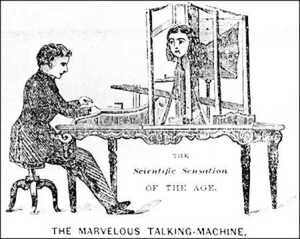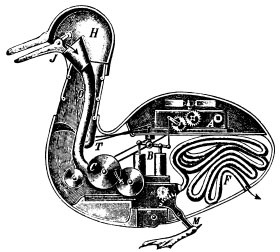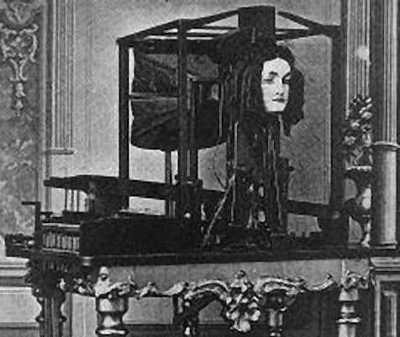The 7 Greatest Robots of the Pre-Modern World
 |
By Patrick Cooper
It’s a fact that one day the robots are going to kill and/or enslave us all. It’s even in the Bible somewhere, trust me. This notion of creations turning against their masters has been a staple of fiction for centuries; from the Jewish folk tale of the Golem to Frankenstein to Battlestar Galactica. However, these cautionary tales still haven’t swayed those with the means of construction from playing god and building blasphemous, soulless machines that will one day eat our kittens and take away our cable. People have been writing about and even designing robots since BCE, but the real robot renaissance began during the Age of Enlightenment and carried throughout the 18th century. The unveiling of new robots would pack theater halls and museums from London to New York City and even royalty couldn’t resist the draw of these eerily real creations. Some merely played instruments and some simulated defecation, but no matter how innocent the action, they’re all permanently written in the blueprint of our destruction.
7) The Female Musician at the Court of Louis 16th
A fembot designed for unnatural pleasure in the guise of a harpsichord-playing lady of royalty? Nice. Several noted historians claim that Louis XVI would defile this talented robot while his wife of flesh and bone was sleeping upstairs. Some even claim her spine glowed a red hue while the lascivious Louis had his way with her. Actually, none of that’s true. All this automata really did was blink and play Baroque music on a harpsichord. But the impressive thing was that she really did play the instrument; pressing the keys and moving her head accordingly — hey, that was impressive for 1770, work with me, folks. She could play a total of 24 notes and when paired with other musical automata I’m sure she really sounded quite nice…okay, you win. She was just a music box with nice tits.
6) The Flute Player of 1738
French engineer and watchmaker Jacques de Vaucanson built several robots during his life including the first successful biomechanical android, the Flute Player. It took four years for Vaucanson to construct this life-sized wooden statue of a man dressed like an idiot. After those long, grueling years, Vaucanson created something that could, well… play the flute. The Flute Player could perform 11 different songs on his transverse flute while imitating the necessary movements of human lips, hands, and lungs. In 1738, Vaucanson premiered his creation at the Hotel de Longueville in Paris and exploded viewer’s 18th century minds. The Duke of Luynes, chronicler at the Royal Court and amateur robot critic, was at the exhibition and commented, “air really blows out through the mouth and the fingers actually play.” The duke should have pulled out his flintlock right then and there and blew the android’s wooden head off, saving us all from damnation.
5) The Digesting (and Pooping) Duck of 1739
Another Jacques de Vaucanson joint. In 1739 he stole the hearts of children and immature adults alike with the drinking, quacking, and defecating Digesting Duck. The small automata would appear to eat kernels of grain and then the audience was allowed to watch as the kernel travelled through the cross-section of the duck’s abdomen; following it to the end when a green substance would drip out of the duck’s asshole. Awesome. Vaucason did his best to imitate an actual digestive process, but even he admitted that the process could not “make blood and nourishing particles to nurture the animal.” Thanks for clearing that up, pal. Of course, the duck did not actually digest anything; this was before they had indoor plumbing let alone the know-how to put together a robot that could actually digest food. Once “eaten,” the food was stored in a container and the faux duck shit would come out of another. 18th century smartass Voltaire summed it up perfectly when he said, “without […] the duck of Vaucanson, you have nothing to remind you of the glory of France.”
4) Leonardo Da Vinci’s Terminator
Leonardo da Vinci sketched up the designs for the first humanoid robot in 1495 and we all should be grateful he never built the damn thing. Why? Because it was designed to fucking kill us all. According to the sketches, the robot would be clad in Italian style armor and have the ability to sit-up and move its arms, neck, and jaw. With those kinds of abilities, this mighty mechanical juggernaut would have certainly wiped out anything in its path and we would all be in slime pods powering the Matrix right now. The designs weren’t discovered until 1950 and the robot was actually built by professor Mario Taddei of Milan, who will most certainly work for Skynet one day.
3) Antonio Diavolo, Chucky of the 1800s
18th century Parisian magician and mechanical clockmaker Jean Eugene Robert-Houdin frequently combined his stage illusions with mechanical figures of his own construction. Seeing the public’s fascination with the creations of artisans like Vaucanson, Robert-Houdin saw the potential for robots more geared towards the stage. He created several ingenious robots during his career: a confectioner automaton that served the audience cakes and liquor, an orange tree which would produce flowers, fruit, and the handkerchief of a chosen audience member, and a nightmarish little demon by the name of Antonio Diavolo. Robert-Houdin would carry this little hell-spawn onto the stage, place it on a miniature trapeze wire, and Diavolo would then greet the audience. He’d bow to every corner of the theater, perform a series of intricate trapeze maneuvers, hang by his feet, and then come down from the wire. He would even take a break and smoke a pipe once in awhile. Now, there’s no evidence suggesting that Robert-Houdin somewhere in his life sold his soul to the Devil, but c’mon. Sure, Diavolo was controlled in part by pulleys and levers off in the wings of the theater, but it would probably be a bad idea to sleep in the same room as him. Chances are he would rise from his trunk, stealthily creep over to your bed, slit your throat, and wash his joints with your blood.
2) The Terrifying Talking Head of 1845
Created by engineer Joseph Faber in 1845, this abomination was originally intended to be used as an addition to the telegraph. Faber wished to convert the dots and dashes used in telegraph communication into a real, coherent human voice. What instead emerged from his laboratory was a nightmare pulled from the collective imagination of all the fallen angels of Hell. Look at that fucking thing. Imagine that, but talking to you. One eye witness stated that the machine had a “ghostly” and “monotone” voice. HAL, anyone? The cold, lifeless face was controlled by a series of piano keys and pedals which projected 16 basic sounds which could be manipulated in such a manner that replicated “every word in all European languages.” The machine was quickly bought by professional bullshit artist P.T. Barnum who tried to misdirect people from its terrifying appearance by billing it under the unassuming name of “Euphonia.” The bitch was a massive success and toured several countries. Barnum later sold it to a horny well-to-do in London for God knows what.
1) “The Turk”
<
a href="http://www.toplessrobot.com/Turk.jpg" onclick="window.open('http://www.toplessrobot.com/Turk.jpg','popup','width=600,height=523,scrollbars=no,resizable=no,toolbar=no,directories=no,location=no,menubar=no,status=no,left=0,top=0'); return false">
Before Deep Blue vs. Kasparov, there was the Turk vs. the World. Designed in the late 18th century by Hungarian inventor Wolfgang von Kempelen, the Turk would be exhibited for over 80 years, leaving a trail of defeated chess opponents in its wake. It wasn’t until the 1820s that the Turk was revealed to be hoax, but this was only after he made fools out of challengers such as Napoleon I and Benjamin Franklin. Before an exhibition, the presenter would open two cabinets so the audience could see there was no one inside controlling the Turk. Then a third cabinet would be opened to reveal a mess of tightly-packed machinery, the “brains” of the Turk. The trick was that an average size chess master would recline within the machine, unseen by the audience, and control the movements of the Turk through levers and magnets. The Turk later retired and was put on display in the Chinese Museum in Philadelphia, where it was destroyed in a fire. Although just a clever hoax, the Turk raised a lot of questions about the potential for robots that could think and make cognitive decisions. And we all know how this turns out (see: episode three of the Sarah Conner Chronicles).
